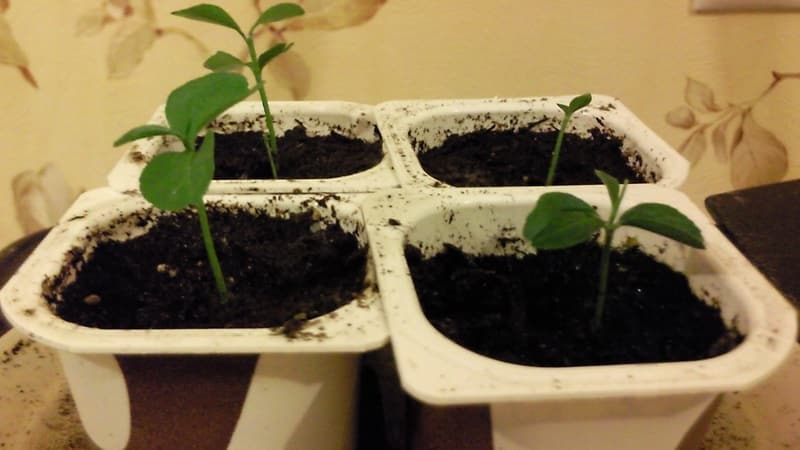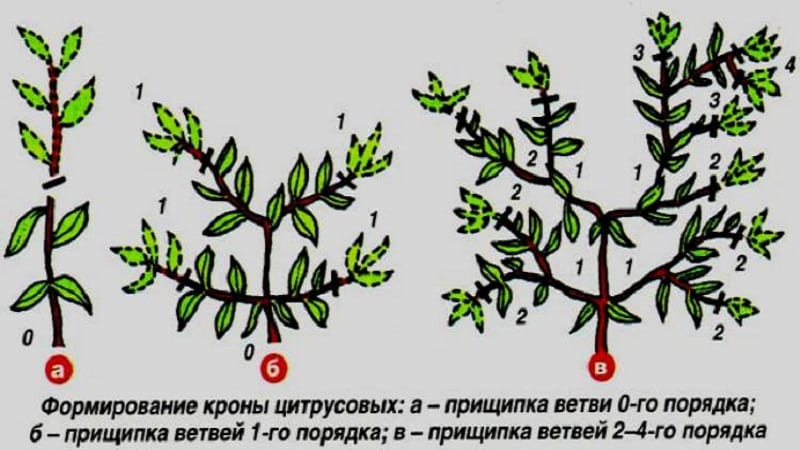Is it possible to grow an orange from a seed and how to do it at home
Growing citrus fruits at home is not an easy task. But after a few years filled with anticipation, the orange will bloom and fill the whole house with an indescribable aroma. The plant blooms for a long time, bears a lot of fruit, and a well-deserved reward awaits the patient owner - fragrant and juicy oranges grown with his own hands. The article contains proven and useful information on how to grow an orange from a seed at home.
Is it possible to grow an orange tree from a seed?
The easiest way is to go to the store and buy a ready-made seedling. They are often sold already bearing fruit. However, this way has drawbacks: orange does not like “moving”, and such plants are fed with special gels, without which the tree may get sick.

In addition, prolonged stay in the same room with plants of other species in a small area greatly increases the risk of pests and diseases.
Most reliable way to grow orange healthy - plant with a seed.
Advantages and disadvantages of this method
There are many advantages: you know exactly the taste of future fruits, enjoy the growing process and can watch how your indoor plant - orange - develops.
There are also disadvantages:
- the risk that the seed will not hatch;
- the need to graft a seedling with a cultivated bud or twig;
- long wait for harvest.
Rules for growing at home
To obtain 100% results, take into account the specifics of planting and care.. Then the orange at home will grow beautiful, healthy and fruitful.

Selection and preparation of seeds
Dried grains cannot be used as planting material.. The orange seed shell is thick and durable - it should protect the future sprout from negative environmental factors. If it dries out, you won’t be able to wait until it pecks. The grains of a freshly eaten orange are washed and placed in a humid environment for a day. Then they begin planting.
Important! Adding biostimulants, for example, "Kornevin", doubles the chances of germination.
Soil preparation
The substrate for growing indoor oranges from seeds consists of the following components:
- 2 parts of turf;
- 1 part peat;
- 1 part humus;
- 1 part sand.
A seed for germination can be planted in a peat tablet. Before the first transplant, the soil must be prepared.
Interesting things on the site:
Landing
The prepared seed is planted in a plastic cup to a depth of 1 cm in slightly moistened soil.. Cover with film and put in a warm, dark place. You should not plant more than one grain in one container - the orange does not like transplanting, especially if its fragile roots are damaged. And in one pot, the roots of the sprouts will become thoroughly entangled.

Crop care
Within 1-1.5 months the seeds will germinate. At this time, periodically moisten the soil, preventing it from drying out. Remove the film daily for 2-3 hours - this will prevent mold from forming on the surface of the soil.
Picking and transplanting
At the stage of two true leaves, the orange needs to be assigned to a permanent place.. You will need a pot with a diameter of 8-10 cm and a depth of 12-15 cm. The material of the container does not matter, the main thing is the presence of drainage holes in the bottom.
Important! Orange does not like to be moved, so the most correct procedure would be to transfer the plant with a lump of earth into a prepared pot.
Features and growing conditions
For proper development, the orange is given the proper level lighting, regularly feed and shape the crown.
Temperature and humidity
Since citrus fruits are native to the tropics and subtropics, they need the creation of suitable conditions.
When the humidity level is below 40%, the orange turns yellow and drops its leaves., especially if it grows near a heat source. Therefore, they give him a regular shower, spraying water on the leaves from a spray bottle, or place an open container of water next to the pot.
The optimal temperature for an orange seedling is +18…+24°C. In summer it is left in the fresh air, protected from direct sunlight during the hottest time. In winter, the plant feels comfortable in an apartment.

Watering rules
The soil in the pot should not dry out. Water so that the earthen ball is completely moistened. Excess moisture will drain into the pan, from where it is poured out to prevent the development of mold.
Orange does not tolerate chlorinated water. Water it with melted water, rain water, or water that has stood for at least a day. The optimal temperature is +24…+26°C.
Important! In winter, watering is carried out moderately - no more than 1-2 times a week, as the top layer of soil dries out
Lighting
If there is a lack of sunlight in the autumn-winter period, install fluorescent lamps or special phytolamps.The minimum required daylight hours is 14 hours. Therefore, the lamps are turned on for 2-3 hours in the morning and the same amount in the evening.
Feeding
During the period of intensive growth, oranges are fertilized with a special mineral complex for citrus fruits. Such preparations are sold in gardening stores.
If it is impossible to purchase a ready-made mixture, make it yourself: 25 g of superphosphate, 20 g of ammonium nitrate, 15 g of potassium fertilizers are diluted in 10 liters of water, mixed thoroughly and allowed to stand for 4-6 hours. Water the orange once every 10 days.
Read also:
Crown formation and pruning
When the seedling reaches a height of 25-30 cm, “disciplinary” measures begin. If crown formation is not carried out, fruiting may not be expected, since flowers and ovaries are formed only on branches of the fourth order.
Crown formation begins in spring:
- Cut the main trunk to a height of no more than 25 cm.
- All side shoots are cut out, except for the 3-4 most powerful ones.
- The remaining side branches are pruned so that they have 4-5 leaves. Second order branches will grow on them.
- A year later, two of the resulting second-order shoots are left on each branch. These shoots will give branches of the third order (from two to five).
- From the branches of the third order, horizontal stems will begin to form, on which buds and fruits will form.
The first time you should not admire the flowering for a long time - it is better to cut off all the buds that appear so that the tree does not weaken. You can leave a maximum of 2-3 solely for pleasure - to observe the first results of your labors.

Flowering and fruiting
To speed up maturation, oranges are put into “hibernation”: put in a cool place for three months, reduce watering as much as possible (to once every 2-3 weeks) and do not feed. Having experienced stress, when returning to normal conditions the plant will begin to actively form buds. In order not to overload the orange with fruits, no more than three ovaries are left on each shoot.
An orange grown from a seed will begin to bear fruit no earlier than 8-10 years. A grafted seedling is twice as fast. The fruits take a very long time to fill – from 7 to 9 months.
Important! With proper care, an orange grows on a windowsill and actively bears fruit for 50-70 years.
Maintenance in winter
An adult orange that has entered the fruiting season needs regular rest.. Otherwise, the tree will become exhausted and die. Therefore, in winter it is watered less and given additional light. During the cold period, orange feels ideal on an insulated loggia.
Disease and pest control
In their natural environment, oranges have few enemies due to essential oils and strong, almost invulnerable leathery leaves. At home, the plant is susceptible to root rot due to improper care and stagnation of water.. If a disease is detected, the orange is transplanted into clean soil, removing the damaged roots. The chance of saving the orange is small, but there is a chance.
Another problem is rust.. When affected, the leaves curl, become covered with dark spots and fall off. Spraying with fungicides "Medex", "Skor" or "Strobi" helps.
Pests that can settle on an orange are aphids, spider mites and scale insects. Daily inspection of the plant is required for prevention.When pests appear, they are removed if possible, and the tree is treated with insecticides “Aktara”, “Fitoverm”, “Aktellik”.
Attention! Insects are not as dangerous to oranges as the infections they carry.
Conclusion
Growing an orange from a seed is a fun and not troublesome activity. Water in a timely manner, provide lighting, humidity and temperature - everything that is required for the normal development of the seedling. A properly formed crown will allow you to obtain a rich harvest for many decades.